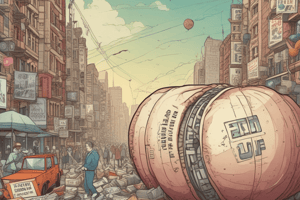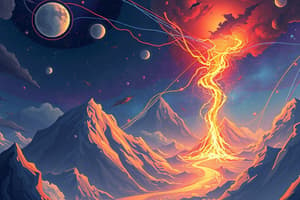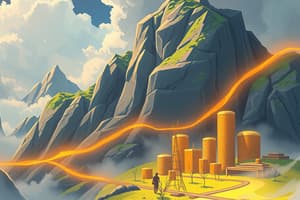Podcast
Questions and Answers
What is inflation in the context of economics?
What is inflation in the context of economics?
- A stable price level of goods and services over time
- A sudden change in the general price level of goods and services
- A sustained increase in the general price level of goods and services (correct)
- A sustained decrease in the general price level of goods and services
What happens when the overall price level rises?
What happens when the overall price level rises?
- Each unit of currency buys fewer goods and services (correct)
- Each unit of currency becomes worthless
- Each unit of currency buys more goods and services
- Each unit of currency buys the same amount of goods and services
What is the usual measure of inflation?
What is the usual measure of inflation?
- Gross Domestic Product (GDP) growth rate
- Percentage increase in the Consumer Price Index (CPI) (correct)
- Unemployment rate
- Interest rate
What is demand-pull inflation caused by?
What is demand-pull inflation caused by?
What is an example of a scenario that could lead to demand-pull inflation?
What is an example of a scenario that could lead to demand-pull inflation?
What is cost-push inflation caused by?
What is cost-push inflation caused by?
What is a consequence of a sustained increase in the general price level of goods and services?
What is a consequence of a sustained increase in the general price level of goods and services?
What is a common characteristic of both demand-pull and cost-push inflation?
What is a common characteristic of both demand-pull and cost-push inflation?
Which of the following is NOT a direct cause of demand-pull inflation?
Which of the following is NOT a direct cause of demand-pull inflation?
What is a potential consequence of cost-push inflation?
What is a potential consequence of cost-push inflation?
What is the name of the index used to measure the rate of inflation?
What is the name of the index used to measure the rate of inflation?
When does demand-pull inflation occur?
When does demand-pull inflation occur?
What is an example of a scenario that could lead to cost-push inflation?
What is an example of a scenario that could lead to cost-push inflation?
Flashcards are hidden until you start studying
Study Notes
Inflation
- Sustained increase in the general price level of goods and services in an economy over a period of time
- Each unit of currency buys fewer goods and services when the overall price level rises
- Measured as a percentage increase in the Consumer Price Index (CPI) over a given period (e.g., annually or monthly)
Causes of Inflation
Demand-Pull Inflation
- Occurs when aggregate demand for goods and services exceeds aggregate supply
- Excess demand leads to higher prices as suppliers increase prices to balance the demand-supply gap
- Examples:
- Government increases public spending
- Government lowers taxes, resulting in people having more money to spend
Cost-Push Inflation
- Results from an increase in the cost of production for businesses
- Businesses pass on increased costs to consumers in the form of higher prices
- Examples:
- Rise in oil prices, increasing the cost of production for goods that rely on oil
Inflation
- Sustained increase in the general price level of goods and services in an economy over a period of time
- Each unit of currency buys fewer goods and services when the overall price level rises
- Measured as a percentage increase in the Consumer Price Index (CPI) over a given period (e.g., annually or monthly)
Causes of Inflation
Demand-Pull Inflation
- Occurs when aggregate demand for goods and services exceeds aggregate supply
- Excess demand leads to higher prices as suppliers increase prices to balance the demand-supply gap
- Examples:
- Government increases public spending
- Government lowers taxes, resulting in people having more money to spend
Cost-Push Inflation
- Results from an increase in the cost of production for businesses
- Businesses pass on increased costs to consumers in the form of higher prices
- Examples:
- Rise in oil prices, increasing the cost of production for goods that rely on oil
Studying That Suits You
Use AI to generate personalized quizzes and flashcards to suit your learning preferences.




